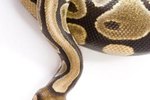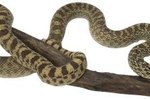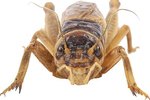
Don't panic if your pet store or supplier runs out of mice for a week or two; like most snakes, sand boas can endure long fasts without suffering. If, you will not be able to obtain mice for a month or more, though, you'll need to secure an alternative food. Well-acclimated captive-bred sand boas will consume a variety of birds and rodents.
Wild Diet
Captive sand boas usually eat a diet of exclusively mice. However, in the wild, sand boas will eat virtually anything they can catch. Sand boas will eat rodents, birds and lizards. They kill prey by constriction or by dragging it under the surface of the sand.
Techniques for Switching Foods
While most sand boas will readily accept unusual food items, they are individuals; each has preferences. Occasional specimens may be finicky, eating only one prey species, offered in a specific manner. Scent transfer techniques may help if your snake repeatedly refuses the new item. Conditioning pet snakes to accept frozen-thawed rodents is good practice, but if you typically offer live or freshly killed prey, use the same technique with the substitute prey item. While wild sand boas may consume lizards, lizards are not appropriate for captive snakes as they are usually full of parasites.
Adjusting the Size and Quantity
One of the biggest advantages snakes have over other pets is their slow metabolism; snakes like sand boas need only about 2 to 4 times their body weight in food per year. A large adult sand boa weighs about 1 pound, and it takes about 15 mice to make a pound, therefore a large sand boa can thrive on approximately 30 mice per year. While there are nutritional differences between various rodent and bird species, they are close enough that you can consider them interchangeable. When using prey species other than feeder mice, use the same guideline for quantity and size. Sand boas have relatively small mouths and aren't adapted to eating very large prey. Regardless of the type of prey you use, make sure that each feeding specimen is about 25 to 50 grams in weight.
Alternative Mammals
Appropriate-size rats are fine prey for sand boas; some keepers use rats for their sand boa’s standard diet. Advanced keepers and breeders debate the subtle nutritional differences between rats and mice, but for the purposes of keeping your pet snake healthy during a supply disruption, the two are interchangeable. Your sand boa can eat hamsters or gerbils if your supplier stocks them. Some rodent distributors carry other small rodents, such as hairless rats, African soft-furred rats or African pygmy mice; as long as they are the appropriate size for your boa, they are acceptable food sources. If you can find them in small-enough sizes, young rabbits are a fine choice as well.
Birds
Hatchling chickens, ducks and quail are suitable prey items for sand boas, but use discretion: The feces of snakes that have eaten birds are often exceptionally foul-smelling. Accordingly, some snake keepers eschew the use of birds. Many large rodents distributors nevertheless stock birds for use as reptile food.
References
Photo Credits
-
David De Lossy/Digital Vision/Getty Images




